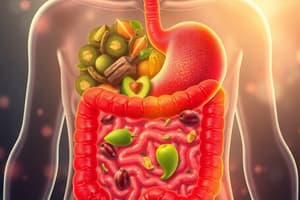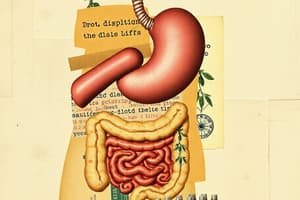Podcast
Questions and Answers
¿Cuál de las siguientes enzimas descompone las grasas en ácidos grasos y glicerol?
¿Cuál de las siguientes enzimas descompone las grasas en ácidos grasos y glicerol?
¿Qué trastorno digestivo se caracteriza por una sensación de ardor en el pecho causada por reflujo ácido?
¿Qué trastorno digestivo se caracteriza por una sensación de ardor en el pecho causada por reflujo ácido?
¿Cuál de las siguientes opciones NO es un trastorno digestivo?
¿Cuál de las siguientes opciones NO es un trastorno digestivo?
¿Qué órgano produce la mayor parte del jugo digestivo?
¿Qué órgano produce la mayor parte del jugo digestivo?
Signup and view all the answers
¿Cuál de las siguientes opciones es un factor que regula la digestión?
¿Cuál de las siguientes opciones es un factor que regula la digestión?
Signup and view all the answers
En el proceso de digestión, ¿cuál es la función principal del esófago?
En el proceso de digestión, ¿cuál es la función principal del esófago?
Signup and view all the answers
¿Cuál es la principal función del intestino delgado en el proceso digestión?
¿Cuál es la principal función del intestino delgado en el proceso digestión?
Signup and view all the answers
¿Qué órgano produce la bilis, que ayuda a digerir las grasas?
¿Qué órgano produce la bilis, que ayuda a digerir las grasas?
Signup and view all the answers
El proceso de movimiento muscular que propulsa los alimentos a través del tracto digestivo se llama:
El proceso de movimiento muscular que propulsa los alimentos a través del tracto digestivo se llama:
Signup and view all the answers
¿Qué es la quimificación?
¿Qué es la quimificación?
Signup and view all the answers
El páncreas produce enzimas digestivas y:
El páncreas produce enzimas digestivas y:
Signup and view all the answers
¿Qué órgano es responsable de la eliminación de los desechos del cuerpo después de la digestión?
¿Qué órgano es responsable de la eliminación de los desechos del cuerpo después de la digestión?
Signup and view all the answers
La amilasa es una enzima que descompone:
La amilasa es una enzima que descompone:
Signup and view all the answers
Flashcards
Sistema digestivo
Sistema digestivo
Conjunto de órganos que descomponen alimentos en nutrientes absorbibles.
Ingestión
Ingestión
Proceso de tomar comida en la boca, iniciando la digestión.
Digestión mecánica
Digestión mecánica
Descomposición física de los alimentos a través de masticación y mezcla.
Digestión química
Digestión química
Signup and view all the flashcards
Absorción
Absorción
Signup and view all the flashcards
Eliminación
Eliminación
Signup and view all the flashcards
Amilasa
Amilasa
Signup and view all the flashcards
Intestino delgado
Intestino delgado
Signup and view all the flashcards
Lipasa
Lipasa
Signup and view all the flashcards
Pépsina
Pépsina
Signup and view all the flashcards
Acidez estomacal
Acidez estomacal
Signup and view all the flashcards
Constipación
Constipación
Signup and view all the flashcards
Ulceras
Ulceras
Signup and view all the flashcards
Study Notes
Overview of the Digestive System
- The digestive system is a complex series of organs that work together to break down food into nutrients the body can absorb and use for energy and growth.
- It involves mechanical and chemical processes.
Stages of Digestion
- Ingestion: The process of taking food into the mouth. This initiates the digestive process.
- Mechanical Digestion: The physical breakdown of food. This happens through chewing (mastication) and churning in the stomach. It increases the surface area for chemical digestion.
- Chemical Digestion: Breaks down complex food molecules into simpler absorbable nutrients. Enzymes play a major role in this process. Enzymes are proteins that speed up chemical reactions.
- Absorption: The transfer of digested nutrients from the digestive tract into the bloodstream. This mainly occurs in the small intestine.
- Elimination: The removal of undigested food and waste products from the body. This happens through the large intestine and the anus.
Organs and their Functions
- Mouth: Mechanical digestion (chewing) begins here, and salivary amylase, an enzyme, starts the chemical breakdown of carbohydrates.
- Esophagus: A muscular tube that transports food from the mouth to the stomach. Peristalsis, wave-like contractions of muscles, propels food through the esophagus.
- Stomach: A muscular sac that mixes food with stomach acid (Hydrochloric acid) and enzymes (pepsin) to break down proteins. The stomach also stores food temporarily.
- Small Intestine: The primary site of nutrient absorption. It has villi and microvilli, increasing the surface area for absorption.
- Pancreas: Produces enzymes (amylase, lipase, protease) that help break down carbohydrates, fats, and proteins in the small intestine. The pancreas also produces bicarbonate to neutralize acidic chyme coming from the stomach.
- Liver: Produces bile, which helps digest fats. Bile is stored in the gallbladder and released into the small intestine. The liver also processes nutrients absorbed into the bloodstream. It plays a crucial role in detoxification.
- Large Intestine: Absorbs water and electrolytes from undigested food. It also forms and stores feces. The colon and rectum are parts of the large intestine, playing a vital role in the elimination process.
- Rectum: Stores feces until elimination.
- Anus: The opening through which feces are expelled from the body.
Key Digestive Enzymes
- Amylase: Breaks down carbohydrates into simpler sugars.
- Lipase: Breaks down fats into fatty acids and glycerol.
- Pepsin: Breaks down proteins into smaller peptides.
Digestive Disorders
- Heartburn: A burning sensation in the chest caused by acid reflux.
- Constipation: Difficulty in emptying bowels.
- Diarrhea: Frequent passage of loose, watery stools.
- Ulcers: Open sores in the lining of the digestive tract.
- Crohn's disease and ulcerative colitis: Inflammatory bowel diseases (IBD) affecting the different parts of the digestive tract
Regulation of Digestion
- The nervous system and hormones regulate the different stages of digestion.
- Hormones released by the stomach and small intestine control the release of digestive juices and the movement of food through the digestive system.
Importance of Proper Digestion
- Proper digestion is crucial for providing the body with essential nutrients needed for growth, repair, and overall health.
- Malnutrition can result from improper digestion.
Studying That Suits You
Use AI to generate personalized quizzes and flashcards to suit your learning preferences.
Description
Este cuestionario explora el sistema digestivo y sus etapas clave, desde la ingestión hasta la eliminación. Los participantes aprenderán sobre los procesos mecánicos y químicos que permiten al cuerpo absorber nutrientes esenciales. Sumérgete en el fascinante viaje de la digestión y descubre cómo funcionan nuestros órganos.




